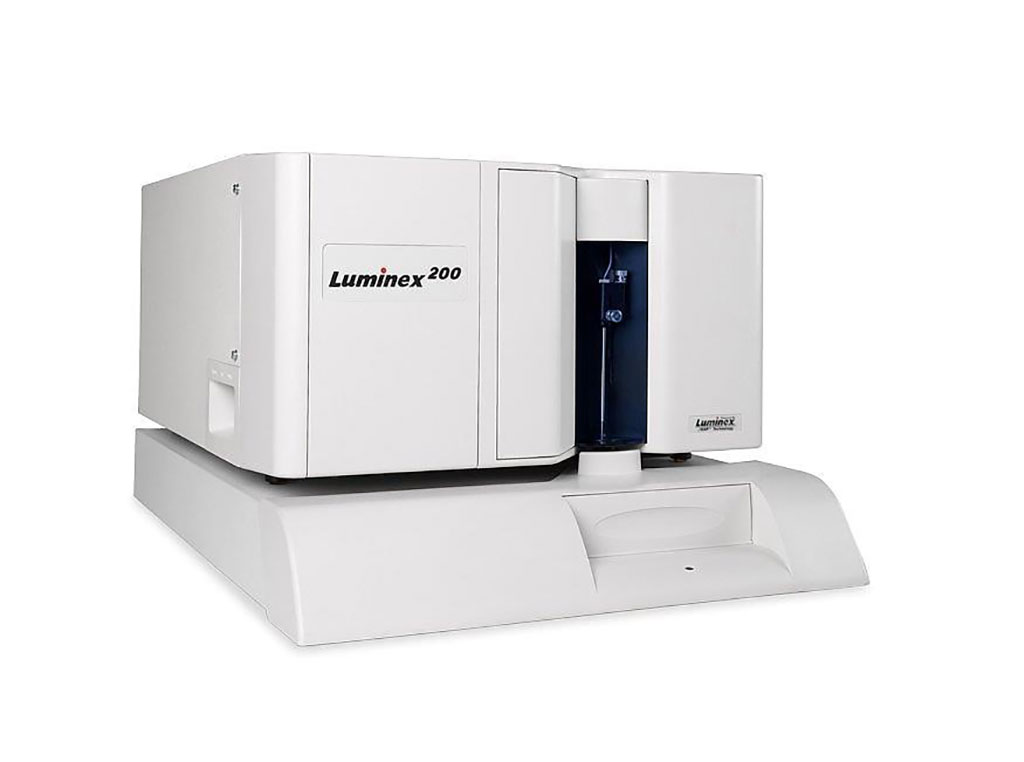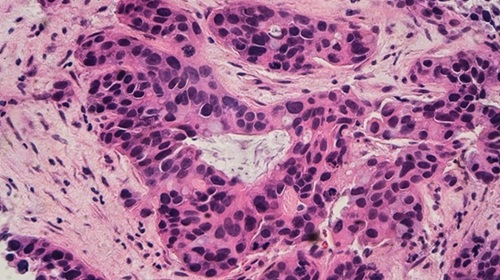Inflammatory Cytokines Measured in Infants Born to Preterm Preeclamptic Mothers
|
By LabMedica International staff writers Posted on 29 Nov 2021 |

Image: The Luminex 200 Instrument System sets the standard for multiplexing, providing the ability to perform up to 100 different tests in a single reaction volume on a flow cytometry-based platform (Photo courtesy of Luminex Corp)
Preeclampsia is both a vascular and inflammatory disorder. The pathophysiology of preeclampsia is complex and rooted in the interplay between maternal and placental factors with the key characteristics of maternal inflammation and vascular etiologies.
The maternal pathophysiology impacts fetal physiology through the filter of the placenta. Triggers of the fetal inflammatory response are not completely understood, as there is contradictory evidence as to whether cytokines directly cross the placenta-blood barrier and emerge on the fetal side or if the fetal inflammatory response is indirectly triggered.
Clinical Scientists at the University of Colorado Anschutz Medical Campus (Aurora, CO, USA) conducted a prospective inceptional cohort study of preterm preeclampsia from July 1, 2010, through June 30, 2012. Eighty-one maternal-newborn dyads were examined. Placentas were analyzed for inflammatory and vascular pathologies. Neurodevelopmental assessment of infants utilizing the Pediatric Stroke Outcome Measure (PSOM) was conducted at 6-month corrected gestational age.
Maternal venous blood samples were collected at time of enrollment and within two hours after delivery. Fetal cord blood venous samples were obtained immediately after delivery by trained perinatal nurses with experience in venous cord blood collection. Platelet-poor plasma was aliquoted, frozen, and sent for cytokine analysis (IL-1β, IL-6, IL-8, and TNF-α) via the Luminex multicode assay platform (Luminex Corp, Austin, TX, USA). Placenta analysis assessments were conducted by a placental pathologist.
The investigators reported that worse neurological outcomes were not associated with elevated maternal / fetal cytokines. Early preterm birth (gestational age ≤ 32 weeks) was associated with worse neurological outcomes at 6-months regardless of maternal/ fetal cytokine levels, placental pathology, or cranial ultrasound findings (OR 1.70). When correcting for gestational age, elevated IL-6 approached significance as a predictor for worse developmental outcome (OR 1.025 ). Pathological evidence of maternal malperfusion and worse outcomes were noted in early preterm, although the sample size was small. When chronic villitis was present (N = 5), higher maternal levels of IL-6 (N = 3; 60%) were usually present rather than in fetal cord blood. Although only three cases of histologic fetal inflammatory response were seen, both IL-6 and IL-8 were elevated in the fetal cord blood (N = 2; 67%), but not elevated in maternal samples.
The authors concluded that their study supports the distinction that 32-weeks gestational age (‘moderate preterm) is a turning point for improved neurological outcomes. They found that cranial ultrasounds were unhelpful in predicting risk in this pre-eclamptic population. The data suggest that maternal placental malperfusion at earlier gestational age may be an underlying factor associated with poor neurological outcomes, although more robust studies are warranted. Neither elevated cytokines nor “male disadvantage” was associated with adverse neurological outcomes. The study was published on November 15, 2021 in the journal PloS One.
Related Links:
University of Colorado Anschutz Medical Campus
Luminex Corp
The maternal pathophysiology impacts fetal physiology through the filter of the placenta. Triggers of the fetal inflammatory response are not completely understood, as there is contradictory evidence as to whether cytokines directly cross the placenta-blood barrier and emerge on the fetal side or if the fetal inflammatory response is indirectly triggered.
Clinical Scientists at the University of Colorado Anschutz Medical Campus (Aurora, CO, USA) conducted a prospective inceptional cohort study of preterm preeclampsia from July 1, 2010, through June 30, 2012. Eighty-one maternal-newborn dyads were examined. Placentas were analyzed for inflammatory and vascular pathologies. Neurodevelopmental assessment of infants utilizing the Pediatric Stroke Outcome Measure (PSOM) was conducted at 6-month corrected gestational age.
Maternal venous blood samples were collected at time of enrollment and within two hours after delivery. Fetal cord blood venous samples were obtained immediately after delivery by trained perinatal nurses with experience in venous cord blood collection. Platelet-poor plasma was aliquoted, frozen, and sent for cytokine analysis (IL-1β, IL-6, IL-8, and TNF-α) via the Luminex multicode assay platform (Luminex Corp, Austin, TX, USA). Placenta analysis assessments were conducted by a placental pathologist.
The investigators reported that worse neurological outcomes were not associated with elevated maternal / fetal cytokines. Early preterm birth (gestational age ≤ 32 weeks) was associated with worse neurological outcomes at 6-months regardless of maternal/ fetal cytokine levels, placental pathology, or cranial ultrasound findings (OR 1.70). When correcting for gestational age, elevated IL-6 approached significance as a predictor for worse developmental outcome (OR 1.025 ). Pathological evidence of maternal malperfusion and worse outcomes were noted in early preterm, although the sample size was small. When chronic villitis was present (N = 5), higher maternal levels of IL-6 (N = 3; 60%) were usually present rather than in fetal cord blood. Although only three cases of histologic fetal inflammatory response were seen, both IL-6 and IL-8 were elevated in the fetal cord blood (N = 2; 67%), but not elevated in maternal samples.
The authors concluded that their study supports the distinction that 32-weeks gestational age (‘moderate preterm) is a turning point for improved neurological outcomes. They found that cranial ultrasounds were unhelpful in predicting risk in this pre-eclamptic population. The data suggest that maternal placental malperfusion at earlier gestational age may be an underlying factor associated with poor neurological outcomes, although more robust studies are warranted. Neither elevated cytokines nor “male disadvantage” was associated with adverse neurological outcomes. The study was published on November 15, 2021 in the journal PloS One.
Related Links:
University of Colorado Anschutz Medical Campus
Luminex Corp
Latest Immunology News
- Gene Signature Test Predicts Response to Key Breast Cancer Treatment
- Chip Captures Cancer Cells from Blood to Help Select Right Breast Cancer Treatment
- Blood-Based Liquid Biopsy Model Analyzes Immunotherapy Effectiveness
- Signature Genes Predict T-Cell Expansion in Cancer Immunotherapy
- Molecular Microscope Diagnostic System Assesses Lung Transplant Rejection
- Blood Test Tracks Treatment Resistance in High-Grade Serous Ovarian Cancer
- Luminescent Probe Measures Immune Cell Activity in Real Time
- Blood-Based Immune Cell Signatures Could Guide Treatment Decisions for Critically Ill Patients
- Novel Tool Predicts Most Effective Multiple Sclerosis Medication for Patients
- Companion Diagnostic Test for CRC Patients Identifies Eligible Treatment Population
- Novel Tool Uses Deep Learning for Precision Cancer Therapy
- Companion Diagnostic Test Identifies HER2-Ultralow Breast Cancer and Biliary Tract Cancer Patients
- Novel Multiplex Assay Supports Diagnosis of Autoimmune Vasculitis
- Blood Test Predicts Immunotherapy Efficacy in Triple-Negative Breast Cancer
- Simple Genetic Testing Could Predict Treatment Success in Multiple Sclerosis Patients
- Novel Gene Signature Predicts Immunotherapy Response in Advanced Kidney Cancers
Channels
Clinical Chemistry
view channel
Chemical Imaging Probe Could Track and Treat Prostate Cancer
Prostate cancer remains a leading cause of illness and death among men, with many patients eventually developing resistance to standard hormone-blocking therapies. These drugs often lose effectiveness... Read more
Mismatch Between Two Common Kidney Function Tests Indicates Serious Health Problems
Creatinine has long been the standard for measuring kidney filtration, while cystatin C — a protein produced by all human cells — has been recommended as a complementary marker because it is influenced... Read moreMolecular Diagnostics
view channel
Blood Protein Profiles Predict Mortality Risk for Earlier Medical Intervention
Elevated levels of specific proteins in the blood can signal increased risk of mortality, according to new evidence showing that five proteins involved in cancer, inflammation, and cell regulation strongly... Read more
First Of Its Kind Blood Test Detects Gastric Cancer in Asymptomatic Patients
Each year, over 1 million people worldwide are diagnosed with gastric (stomach) cancer, and over 800,000 people die of the disease. It is among the top 5 deadliest cancers worldwide for both men and women.... Read moreHematology
view channel
Platelet Activity Blood Test in Middle Age Could Identify Early Alzheimer’s Risk
Early detection of Alzheimer’s disease remains one of the biggest unmet needs in neurology, particularly because the biological changes underlying the disorder begin decades before memory symptoms appear.... Read more
Microvesicles Measurement Could Detect Vascular Injury in Sickle Cell Disease Patients
Assessing disease severity in sickle cell disease (SCD) remains challenging, especially when trying to predict hemolysis, vascular injury, and risk of complications such as vaso-occlusive crises.... Read more
ADLM’s New Coagulation Testing Guidance to Improve Care for Patients on Blood Thinners
Direct oral anticoagulants (DOACs) are one of the most common types of blood thinners. Patients take them to prevent a host of complications that could arise from blood clotting, including stroke, deep... Read moreMicrobiology
view channel
Rapid Assay Identifies Bloodstream Infection Pathogens Directly from Patient Samples
Bloodstream infections in sepsis progress quickly and demand rapid, precise diagnosis. Current blood-culture methods often take one to five days to identify the pathogen, leaving clinicians to treat blindly... Read more
Blood-Based Molecular Signatures to Enable Rapid EPTB Diagnosis
Extrapulmonary tuberculosis (EPTB) remains difficult to diagnose and treat because it spreads beyond the lungs and lacks easily accessible biomarkers. Despite TB infecting 10 million people yearly, the... Read more
15-Minute Blood Test Diagnoses Life-Threatening Infections in Children
Distinguishing minor childhood illnesses from potentially life-threatening infections such as sepsis or meningitis remains a major challenge in emergency care. Traditional tests can take hours, leaving... Read more
High-Throughput Enteric Panels Detect Multiple GI Bacterial Infections from Single Stool Swab Sample
Gastrointestinal (GI) infections are among the most common causes of illness worldwide, leading to over 1.7 million deaths annually and placing a heavy burden on healthcare systems. Conventional diagnostic... Read morePathology
view channel
AI Tool Rapidly Analyzes Complex Cancer Images for Personalized Treatment
Complex digital biopsy images that typically take an expert pathologist up to 20 minutes to assess can now be analyzed in about one minute using a new artificial intelligence (AI) tool. The technology... Read more
Diagnostic Technology Performs Rapid Biofluid Analysis Using Single Droplet
Diagnosing disease typically requires milliliters of blood drawn at clinics, depending on needles, laboratory infrastructure, and trained personnel. This process is often painful, resource-intensive, and... Read moreTechnology
view channel
AI Saliva Sensor Enables Early Detection of Head and Neck Cancer
Early detection of head and neck cancer remains difficult because the disease produces few or no symptoms in its earliest stages, and lesions often lie deep within the head or neck, where biopsy or endoscopy... Read more
AI-Powered Biosensor Technology to Enable Breath Test for Lung Cancer Detection
Detecting lung cancer early remains one of the biggest challenges in oncology, largely because current tools are invasive, expensive, or unable to identify the disease in its earliest phases.... Read moreIndustry
view channel
Abbott Acquires Cancer-Screening Company Exact Sciences
Abbott (Abbott Park, IL, USA) has entered into a definitive agreement to acquire Exact Sciences (Madison, WI, USA), enabling it to enter and lead in fast-growing cancer diagnostics segments.... Read more






















